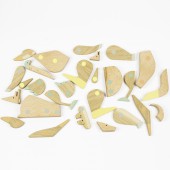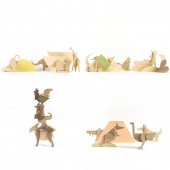
| THE AWARD |
| CATEGORIES |
| REGISTRATION |
| SUBMIT YOUR WORK |
| ENTRY INSTRUCTIONS |
| TERMS & CONDITIONS |
| PUBLICATIONS |
| DATES & FEES |
| METHODOLOGY |
| CONTACT |
| WINNERS |
| PRESS ROOM |
| GET INVOLVED |
| DESIGN PRIZE |
| DESIGN STORE |
| THE AWARD | JURY | CATEGORIES | REGISTRATION | PRESS | WINNERS | PUBLICATIONS | ENTRY INSTRUCTIONS |
Esnaf Wooden Magnetic Toys by Bistra Popova |
Home > Winners > Design #77252 >Interview |
 |
|
FS: What is the main principle, idea and inspiration behind your design?
BP: As qualified architects we explore the architecture of every object they see. We are interested in woodworking and wood modelling for quite some time but it was just a hobby until 7-8 years ago. Then it was decided to take the next step and we came up with the idea of creating wooden toys which could be assembled and disassembled using magnetic joints. The project was sitting aside for couple of years and then in 2013 the true inspiration came when we became parents and this felt like the right moment in time to get the project out to a wider audience.
FS: What has been your main focus in designing this work? Especially what did you want to achieve?
BP: Our main focus was to design a puzzle like intellectual challege toy and we want this works to have a direction of every next collection to explore differen aspect of the design.
FS: What are your future plans for this award winning design?
BP: We plan to develop more new collections and to explore the animals around the world.
FS: How long did it take you to design this particular concept?
BP: One year from the start of the drawings till the final manufactured products.
FS: Why did you design this particular concept? Was this design commissioned or did you decide to pursuit an inspiration?
BP: We decide to explore the specific animals for each continent and we choose to research the Australia continent.
FS: Is your design being produced or used by another company, or do you plan to sell or lease the production rights or do you intent to produce your work yourself?
BP: We intend to produce our work by ourselves and it is not used by another company.
FS: What made you design this particular type of work?
BP: We have this idea in our sketches for a long time and once we became parents we were inspired to make it real.
FS: Where there any other designs and/or designers that helped the influence the design of your work?
BP: No.
FS: Who is the target customer for his design?
BP: Young families with children, design decoration lovers, animal collectors.
FS: What sets this design apart from other similar or resembling concepts?
BP: The minimalistic design and the color magnet joints which are not hided but in a contrary they are exposed and used as a tool of the puzzle game.
FS: How did you come up with the name for this design? What does it mean?
BP: In its origin it means craftsman.
FS: Which design tools did you use when you were working on this project?
BP: Everything is designed and made by hand.
FS: What is the most unique aspect of your design?
BP: The minimalistic design and the color magnet joints which are not hided but in a contrary they are exposed and used as a tool of the puzzle game.
FS: Who did you collaborate with for this design? Did you work with people with technical / specialized skills?
BP: We manufactured it by ourselves because the team is made of people who design and people who have technical skills, people who have business skills. For the package design we use the graphich design studio PUNKT.
FS: What is the role of technology in this particular design?
BP: The technology does not have a main role but it tends to be integrated in the manufacrture process.
FS: Is your design influenced by data or analytical research in any way? What kind of research did you conduct for making this design?
BP: We research the specifiv species of animals in the different continents.
FS: What are some of the challenges you faced during the design/realization of your concept?
BP: The biggest challenge from a creative standpoint was to imagine an engaging interaction between the child and the toy - it had to be both fun and challenging and unique. It had to educate color matching, imagination developing, creativity, good taste and eco-friendly thinking. The creative challenge was to make a handmade eco-friendly product that has minimalist design and can be manufactured in large quantities. It is a challenge to develop a project into a product that is distributed to the final clients. It is a challenge a hobby to become a business. And it is not only a business challenge but a design challenge too.
FS: How did you decide to submit your design to an international design competition?
BP: It was a suggestion from close friends, proffesionalist in design. They adviced that our products are suitable for this kind of competition.
FS: What did you learn or how did you improve yourself during the designing of this work?
BP: We learn about the materials, we explore forms, geometry and we learn about the manufacturing in big quantities and business developing.
FS: Any other things you would like to cover that have not been covered in these questions?
BP: We are challenge to develop the way of playing with our toys, using only the magnet and the wood tool. We also think that the meaning of the design is to develop beautiful space, beautiful products that will inspire people to create beautiful things in their own jobs, lives... Because of this reason we think that children will form this taste and attitude to life playing with minimalistic toys which offers intelectual challenge too.
FS: Thank you for providing us with this opportunity to interview you.
A' Design Award and Competitions grants rights to press members and bloggers to use parts of this interview. This interview is provided as it is; DesignPRWire and A' Design Award and Competitions cannot be held responsible for the answers given by participating designers.
| SOCIAL |
| + Add to Likes / Favorites | Send to My Email | Comment | View Press-Release |




